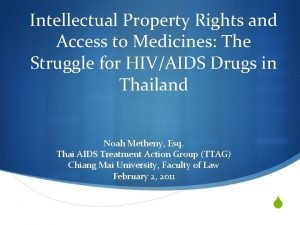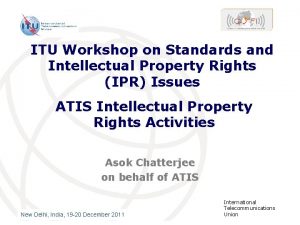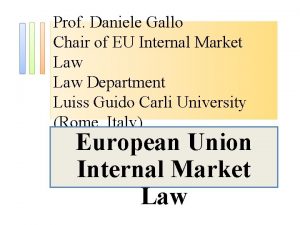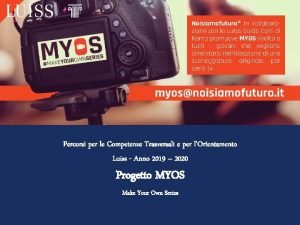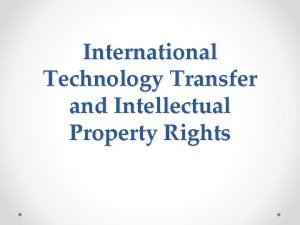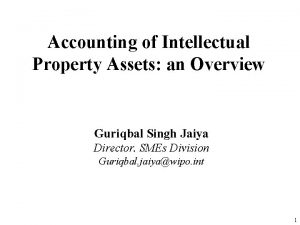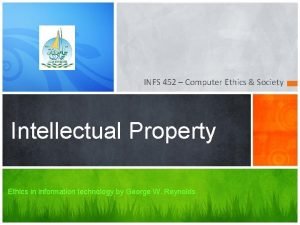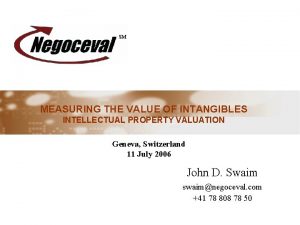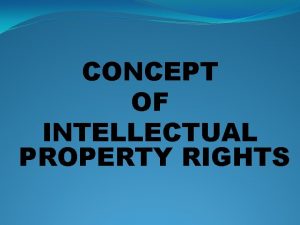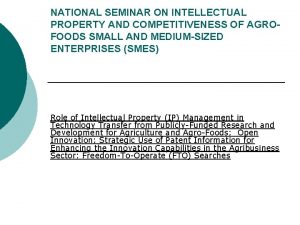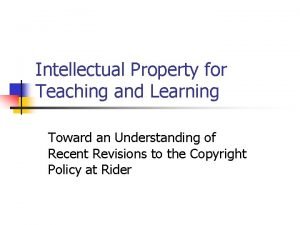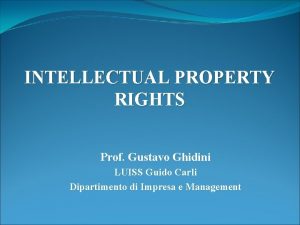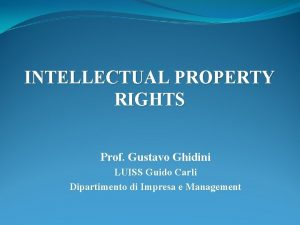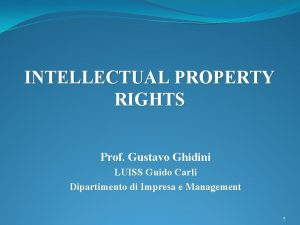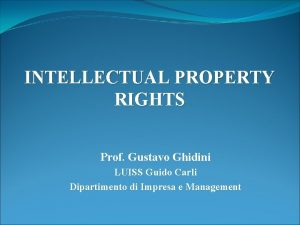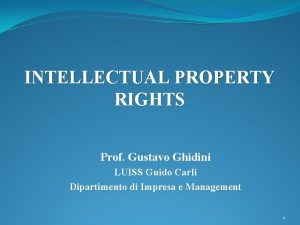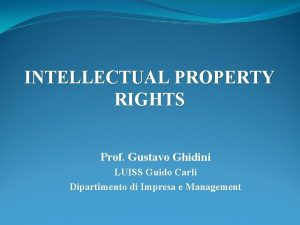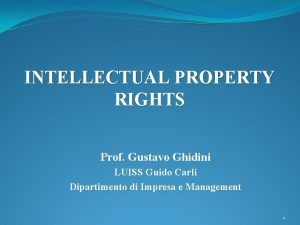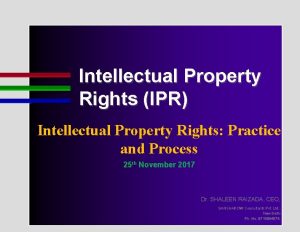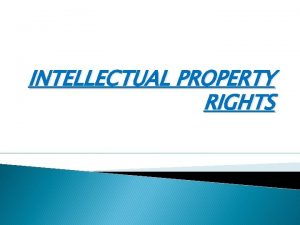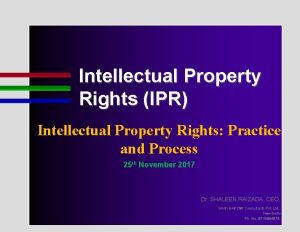INTELLECTUAL PROPERTY RIGHTS Prof Gustavo Ghidini LUISS Guido














- Slides: 14

INTELLECTUAL PROPERTY RIGHTS Prof. Gustavo Ghidini LUISS Guido Carli Dipartimento di Impresa e Management

“Introduction to copyright law” Lesson 9 – 03. 27. 2014 2

Introduction to copyright law - Treaties, EU and Italian legislation - Assumptions and constitutional principles - Protected works - The expansion of copyright 3

Treaties and EU Legislation International Treaties: - Agreement on Trade-Related Aspects of Intellectual Property Rights (TRIPs) 1994 - WIPO Copyright Treaty - WCT 1996 - Berne Convention for the Protection of Literary and Artistic Works 1886 – as revised at PARIS on July 24, 1971 and amended on September 28, 1979 EU Legislation: - Directive 2001/29/EC on the harmonization of certain aspects of copyright and related rights in the information society (INFOSOC – now public. cons. ) • Italian Legislation: - Legge 22 aprile 1941, n. 633 - Protezione del diritto d'autore e di altri diritti connessi al suo esercizio (Law No. 633 of April 22, 1941 Protection of Copyright and Rights Related to its Exercise) 4

Constitutional basis Copyright, that protect the result of creative intellectual activity, expresses tenets of protection of constitutional rank: - the enhancement of intellectual labour, - the encouragement of entrepreneurial production and distribution of intellectual works, - the development and dissemination of colture and knowledge, - the promotion of artistic and scientific freedom, - the freedom of expression in terms of disseminating and receiving information 5

Italian Constitution On one hand: Art. 42 and Art. 35 Cost On the other hand: Art. 9 and 33, Art. 41, Art. 21, Art. 3. 2 Cost See also: Art. I, Section 8, USA Constitution: The Congress shall have Power To (…) To promote the Progress of Science and useful Arts, by securing for limited Times to Authors and Inventors the exclusive Right to their respective Writings and Discoveries; 6

Protected works What is Covered by Copyright? (from WIPO course): As with all fields of intellectual property copyright is concerned with protecting the work of the human intellect. The domain of copyright is the protection of literary and artistic works. These include writings, music, and works of the fine arts, such as paintings and sculptures, and technology-based works such as computer programs and electronic databases. Copyright protects works, that is the expression of thoughts, and not ideas. So if you imagine a plot, this, as such, is not protected. For example, a plot consisting of a story about young men and women falling in love despite family and caste obstacles would not be protected. Different writers may build stories based on a similar plot. But when you express it in a synopsis or in, say, a short story, or a play, the expression of the plot in that story will be protected. Hence, for example, Shakespeare’s play Romeo and Juliet would be considered as a creative expression of that plot. Still, other writers may build new stories based on a similar plot. 7

The Berne Convention, Art. 2 The Berne Convention, which is the oldest international convention Governing copyright, states the following in its Article 2: "The expression 'literary and artistic works' shall include every production in the literary, scientific and artistic domain, whatever may be the mode or form of its expression, such as books, pamphlets and other writings; lectures, addresses, sermons and other works of the same nature; dramatic or dramatico-musical works; choreographic works and entertainments in dumb show; musical compositions with or without words; cinematographic works to which are assimilated works expressed by aprocess analogous to cinematography; works of drawing, painting, architecture, sculpture, engraving and lithography; photographic works, to which are assimilated works expressed by a process analogous to photography; works of applied art; illustrations, maps, plans, sketches and threedimensional works relative to geography, topography, architecture or science. [. . . ] 8

There is no requirement that the literary and artistic work should be good or have artistic merits. It should, however, be original. The exact meaning of this requirement varies from country to country, and it is often determined by case law. 9

a) In very general terms one may say that in countries belonging to the common law tradition very little is required, other than that the work must not be a copy of another work and that the author should have displayed a minimum amount of skill, labor and judgement in making it. b) In countries belonging to the civil law tradition, the requirement is often stronger, for example that the work must bear the stamp of the author's personality. A creative effort would be required from the author that may go beyond mere skill, labor or judgement. 10

Are the works that can be protected under the Berne Convention restricted to the list set out in Article 2? It should be borne in mind that works that are susceptible of being protected under the Berne Convention are not restricted to the examples quoted above. Such a list is not exhaustive. You will have noticed that the Berne Convention specifies that “the expression 'literary and artistic works' shall include every production in the literary, scientific and artistic domain, whatever may be the mode or form of its expression, such as…. ” The expression “such as” opens the door to creations other than the ones set out in the list. For example, court decisions, in different countries, have protected material such as: - private letters, - a divorce guide, - a haircut, - a floral decoration of a bridge, - a son -et -lumiere show, - examination papers. 11

The Italian Copyright Law: Art. 1 and 2 Works Protected Art. 1. : Works of the mind having a creative character and belonging to literature, music, figurative arts, architecture, theater or cinematography, whatever their mode or form of expression, shall be protected in accordance with this Law. Computer programs shall also be protected as literary works within the meaning of the Berne Convention for the Protection of Literary and Artistic Works 1, ratified and enforceable pursuant to Law No. 399 of June 20, 1978, as shall databases that, by reason of the selection or arrangement of their contents, constitute the author’s own intellectual creation. 12

Art. 2. In particular, protection shall extend to: 1. literary, dramatic, scientific, didactic and religious works, whether in written or oral form; 2. musical works and compositions, with or without words, dramaticomusical works, and musical variations that themselves constitute original works; 3. choreographic works and works of dumb show, the form of which is fixed in writing or otherwise; 4. works of sculpture, painting, drawing, engraving and similar figurative arts, including scenic art; 5. architectural plans and works; 6. works of cinematographic art, whether silent or with sound, provided they are not mere documentaries protected in accordance with the provisions of Chapter V of Part II; 7. works of photographic art and works expressed with processes analogous to photography provided they are not simple photographs protected in accordance with the provisions of Chapter V of Part II; 13

8. computer programs, in whatever form they are expressed, provided that they are original and result from the author’s own intellectual creation. Ideas and principles which underlie any element of a computer program, including those which underlay its interfaces, shall be excluded from the protection afforded by this Law. The term “computer program” shall include their preparatory design materials. 9. the databases referred to in the second paragraph of Article 1, understood as being collections of works, data or other independent elements systematically or methodically arranged and individually accessible by electronic means or otherwise. The protection of databases shall not extend to their contents and shall be without prejudice to rights existing in those contents 2. 10. industrial design works that have creative character or inherent artistic character. 14
 Intellectual property rights
Intellectual property rights Trade related aspects of intellectual property rights
Trade related aspects of intellectual property rights Intellectual property in professional practices
Intellectual property in professional practices Intellectual property rights
Intellectual property rights Daniele gallo luiss
Daniele gallo luiss Myos luiss
Myos luiss Importance of intellectual property
Importance of intellectual property Sfas 142
Sfas 142 Intellectual property in computer ethics
Intellectual property in computer ethics Evalueserve ip
Evalueserve ip Valuation of ip
Valuation of ip Concept of intellectual property
Concept of intellectual property Intellectual property management definition
Intellectual property management definition Intellectual property
Intellectual property Right to intellectual property of teachers
Right to intellectual property of teachers
